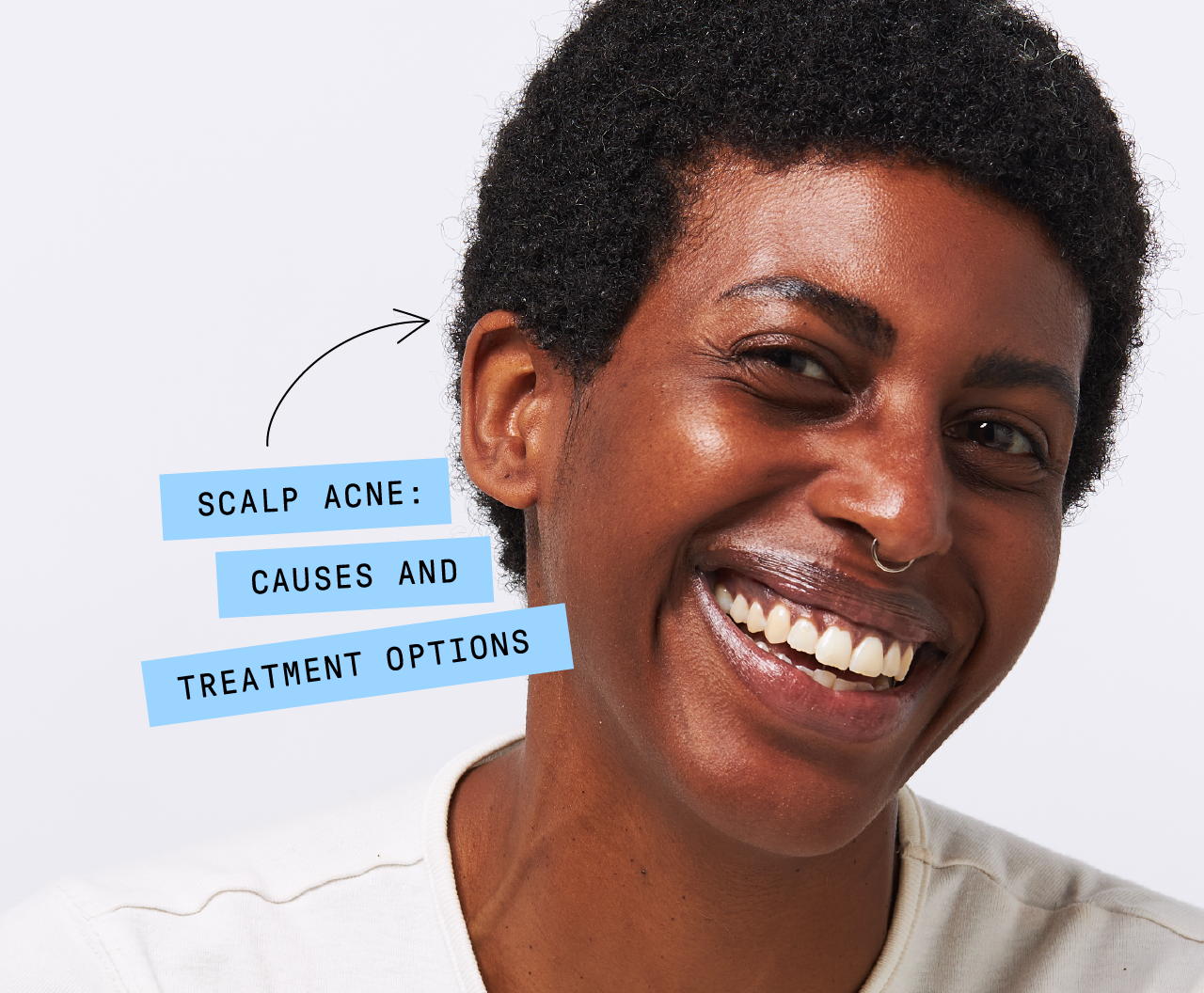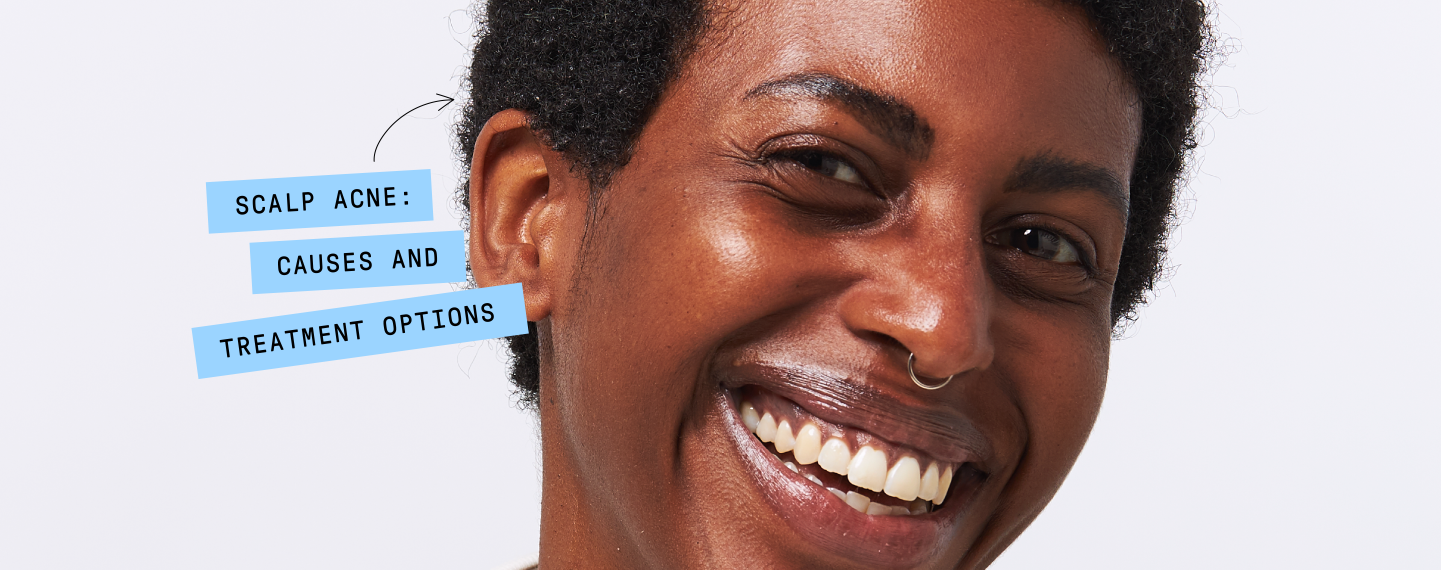Education
Scalp Acne: Causes and Treatment Options


SHARE
Education
Scalp Acne: Causes and Treatment Options
Medically reviewed by Aimee Paik, MD
Written by Apostrophe Team
Last updated 11/1/2024
Pimples anywhere are annoying. But pimples on your scalp can be particularly troublesome — itching and causing pain while they hide beneath your hair.
The first step in getting rid of these scalp zits is understanding the cause. Once you know what you’re dealing with, it’s easier to find an effective treatment.
Rather than trying to dab pimple creams on your head without gunking up your hair, start with understanding the scope of the problem.
Scalp Pimples: What You Need to Know
There are two likely culprits of pimples on your scalp: common acne and folliculitis.
Acne, including scalp acne, is caused by clogged pores, sebum production, inflammation and bacteria.
Hormonal changes, medications, skin care products and even athletic equipment can make you more prone to acne on your scalp and forehead.
Folliculitis is very similar to acne, and is an inflammatory response to things like bacteria or fungi in the hair follicles.
Whether the pimples on your scalp are caused by acne or folliculitis, they’ll likely respond to the same treatments.
Are Your Scalp Pimples Caused By Acne?
You’ve likely heard of it and struggled with some form of it — acne is the most common skin disorder in the United States.
It’s a chronic inflammatory skin condition that results in the formation of various types of pimples or zits.
There are four factors that contribute to acne development: increased sebum or the oil produced by your skin, dead skin cells, bacteria known as Propionibacterium acnes (P. acnes), and inflammation.
Typically, for a pimple to develop, dead skin cells block your hair follicles, and sebum gets trapped beneath the surface of the skin, breeding bacteria and causing inflammation.
The results: one of several different kinds of pimples.
Acne includes pimples known as closed comedones or whiteheads; open comedones or blackheads; papules (small pink bumps); pustules and nodules (both inflammatory and painful types of acne); and cysts, which are deep, pus-filled pimples.
Any number of things can cause acne, including hormonal changes, medications, oily skin, skin care products or even your diet.
If your acne is prominent on your scalp or forehead, you may want to look closely at two possible culprits: hair products and hat usage.
Oil-based hair products could be clogging the pores of your scalp and forehead.
And hat-wearing, particularly after or while sweating, creates a perfectly warm environment for bacteria growth.
Are Your Scalp Pimples Caused By Folliculitis?
Folliculitis is a condition closely related to acne, according to research. It responds similarly to treatment and may have similar causes.
Chronic folliculitis is more common in men than women, and may be caused by bacterial, viral, or fungal factors. While the precise cause of folliculitis isn’t completely understood, it’s believed to be an inflammatory response to conditions — like bacteria or yeasts — within the hair follicle.
Folliculitis looks like acne, too, which makes discerning the difference difficult.
The condition results in small, itchy pustules or pimples on the scalp and hairline. These bumps may itch, become sore, and crust over.
Severe, but less common types of folliculitis include acne necrotica and perifolliculitis capitis abscedens et suffodiens, also known as dissecting cellulitis.
In the former, large follicular bumps develop black crusts and ultimately scars. In the latter, larger pimples such as nodules and cysts may be present, and hair loss and scarring is more common.
Scalp Acne Treatments
Getting a proper diagnosis from a healthcare provider or dermatologist is important for determining how to treat your scalp condition and managing breakouts. However, whether folliculitis or acne, at least some of the treatments would be similar.
Both of these conditions may be improved by oral antibiotics such as tetracycline drugs and isotretinoin.
Acne treatment may also include the use of topical retinoids and benzoyl peroxide. Treatment for folliculitis may include topical steroid creams and antihistamines.
Other solutions may include adjusting the skin and hair care products you use.
Steer clear of oily products that can clog your pores and consider a dandruff shampoo with antifungal medicine.
If you’re a hat-wearer, give your head a break, especially if you’re sweating. And you know that favorite hat you haven’t washed since you bought it? Throw it in the washing machine.
Like what you just read? Sign up for our email list to get the scoop on skincare science delivered straight to your inbox.

Deep Dives
A dermatologist shares his thoughts on the recent studies about benzoyl peroxide and benzene.
Read More
Education
What is milia?
What is milia? Today, we’re jumping into one type of bump that you may have heard about most commonly in infants — milia.
Read More
Education
Best moisturizer for acne-prone skin
If you have combination acne-prone skin, figuring out which moisturizer is best for your skin might be tough. In this guide, we break down the best moisturizer for combination, acne-prone skin.
Read More